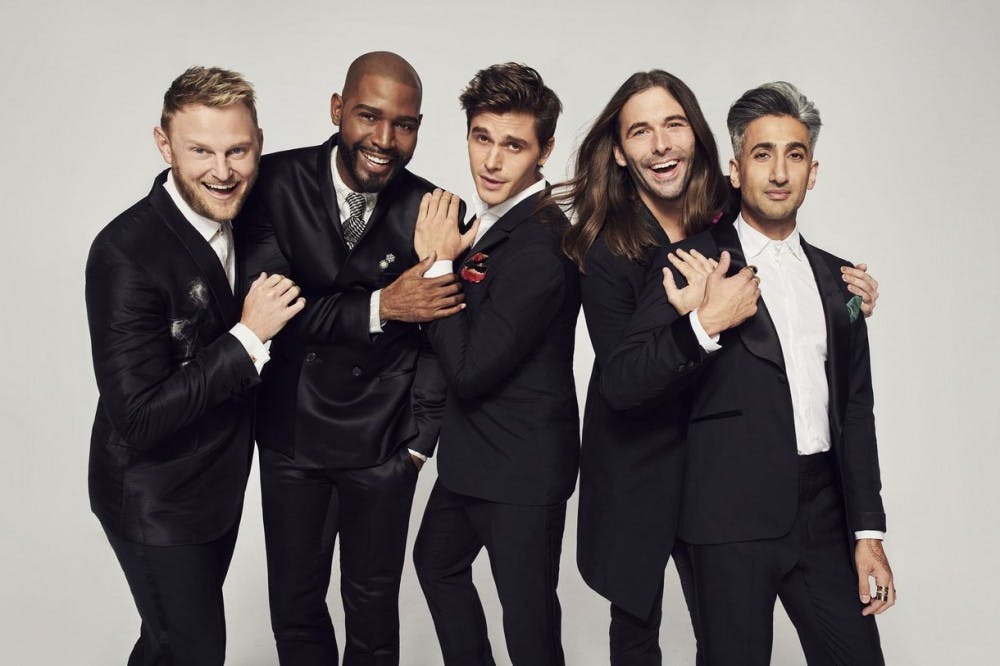Equally as problematic as it is binge-worthy, Netflix’s “Queer Eye” revival reinforces stereotypes about homosexuality and masculinity all the while purportedly debunking them. Originally called “Queer Eye for the Straight Guy,” the show stars the “Fab Five” — a group of gay men each with their own area of expertise (beauty, fashion, culture, food and interior design). In a take similar to Stacey and Clinton’s on “What Not To Wear,” the Fab Five then make over the life of a straight man in need.
Netflix’s Atlanta-based reboot follows this same premise but features a new cast: food and wine connoisseur Antoni Porowski, fashion expert Tan France, culture aficionado Karamo Brown, interior designer Bobby Berk and grooming master Jonathan Van Ness. Undoubtedly the best parts of this reboot, each is charming in his own way. In the pilot episode “You Can’t Fix Ugly,” the Fab Five meet Tom, an older dump-truck driver who loves watching television on his front porch from his recliner while sipping a “Texas Margarita” (a mixture of Mountain Dew and tequila). Though sweet, funny and genuine, Tom’s self-consciousness in his appearance has kept him from living the life he wants and from pursuing the woman he loves.
The Fab Five work tirelessly to convince Tom that “you can’t fix ugly” is a mantra he needs to leave behind. After buying him a new wardrobe, revamping his house, shaping his “ZZ Top beard” into a more manageable mane and teaching him how to make guacamole, Tom reveals his new self to his daughter and proclaims the Fab Five have finally “fixed ugly.” The episode ends in a sea of tears, from Tom, the Fab Five and, unashamedly, from me as a viewer.
Part of what makes “Queer Eye” so endearing is the empathy and sincerity with which the Fab Five approach each of their hopeless heteros. They leave behind the unnecessary harshness that often accompanies makeover shows for a more understanding attitude that helps their criticisms feel constructive. They don’t ask their clients to be anyone they’re not; they aren’t interested in creating new personalities but in helping people learn to devote time and attention to themselves. They meet clients halfway, even electing to try Tom’s Texas Margaritas before condemning them.
This new iteration of “Queer Eye,” set in the South during a particularly politically and socially contentious time, doesn’t shy away from examining larger social issues. Both parties approach these conversations with a vulnerability that makes the physical transformations feel even more significant. Throughout the course of the season, the Fab Five are called in to make over a Trump-supporting police officer, a devout Christian religious leader and a good-old-boy firefighter. In these episodes, members of the Fab Five engage their clients in serious conversations about police brutality and the lack of acceptance of gay people in religion. Understandably, these conversations don’t end in some grand peace between police officers and black men or members of religious sects and homosexuals, but they create a sincere dialogue that seems to bring the men just a little bit closer.
As enjoyable as “Queer Eye” is to watch, its stereotypical treatment of both homosexual and heterosexual men is difficult to overlook. Necessarily, the show reinforces stereotypes about homosexual masculinity — that straight men need people to sort out their lives for them and that gay men are those people, that gayness necessarily brings a worldliness and fashion sense inaccessible to heterosexual men, that gay men understand the qualities important to women in a partner and that toxic heterosexual masculinity can be fixed with nicer clothing and a better-decorated home. While the show is open to bringing attention — however surface-level — to other hot-button issues, it can’t effectively challenge these particular stereotypes about sexuality because it is founded on them. Though fun and lighthearted, “Queer Eye” isn’t doing much for homosexual representation in 2018.
Get The Chronicle straight to your inbox
Signup for our weekly newsletter. Cancel at any time.

